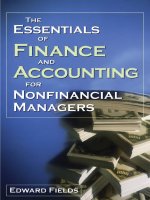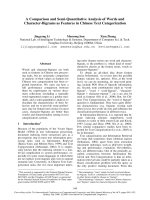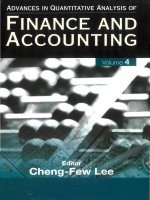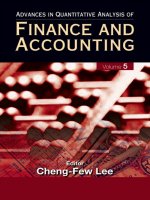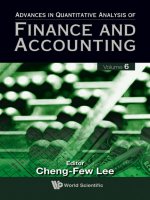ADVANCES IN QUANTITATIVE ANALYSIS OF FINANCE AND ACCOUNTING Volume 5 potx
Bạn đang xem bản rút gọn của tài liệu. Xem và tải ngay bản đầy đủ của tài liệu tại đây (2.64 MB, 345 trang )
ADVANCES IN QUANTITATIVE ANALYSIS OF
FINANCE AND
Accounting
June 8, 2007 3:16 spi-b483 Advances in Quantitative Analysis of Finance and Accounting: Vol.5 edtbd
Advances in Quantitative Analysis of Finance and Accounting
Editorial Board
Cheng F. Lee Rutgers University, USA
Mike J. Alderson University of St. Louis, USA
James S. Ang Florida State University, USA
K. R. Balachandran New York University, USA
Thomas C. Chiang Drexel University, USA
Thomas W. Epps University of Virginia, USA
Thomas J. Frecka University of Notre Dame, USA
Robert R. Grauer Simon Fraser University, Canada
Puneet Handa University of lowa, USA
Der-An Hsu University of Wisconsin, Milwaukee, USA
Prem C. Jain Georgetown University, USA
Jevons C. Lee Tulane University, USA
Wayne Y. Lee Kent State University, USA
Scott C. Linn University of Oklahoma, USA
Gerald J. Lobo University of Houston, USA
Yaw Mensah Rutgers Unversity, USA
Thomas H. Noe Tulane University, USA
Fotios Pasiouras University of Bath, UK
Oded Palmon Rutgers University, USA
Louis O. Scott Morgan Stanley Dean Witter, USA
Andrew J. Senchak University of Texas, Austin, USA
David Smith Iowa State University, USA
K. C. John Wei Hong Kong Technical University, Hong Kong
William W. S. Wei Temple University, USA
Chunchi Wu Syracuse University, USA
Uzi Yaari Rutgers University USA
N E W J E R S E Y
•
L O N D O N
•
S I N G A P O R E
•
B E I J I N G
•
S H A N G H A I
•
H O N G K O N G
•
TA I P E I
•
C H E N N A I
World Scientic
Editor
Cheng-Few Lee
Rutgers University, USA
Volume 5
ADVANCES IN QUANTITATIVE ANALYSIS OF
FINANCE AND
Accounting
British Library Cataloguing-in-Publication Data
A catalogue record for this book is available from the British Library.
For photocopying of material in this volume, please pay a copying fee through the Copyright
Clearance Center, Inc., 222 Rosewood Drive, Danvers, MA 01923, USA. In this case permission to
photocopy is not required from the publisher.
ISBN-13 978-981-270-628-7
ISBN-10 981-270-628-3
Typeset by Stallion Press
Email:
All rights reserved. This book, or parts thereof, may not be reproduced in any form or by any means,
electronic or mechanical, including photocopying, recording or any information storage and retrieval
system now known or to be invented, without written permission from the Publisher.
Copyright © 2007 by World Scientific Publishing Co. Pte. Ltd.
Published by
World Scientific Publishing Co. Pte. Ltd.
5 Toh Tuck Link, Singapore 596224
USA office: 27 Warren Street, Suite 401-402, Hackensack, NJ 07601
UK office: 57 Shelton Street, Covent Garden, London WC2H 9HE
Printed in Singapore.
ADVANCES IN QUANTITATIVE ANALYSIS OF FINANCE AND ACCOUNTING
Advances in Quantitative Analysis of Finance and Accounting — Vol. 5
June 28, 2007 8:15 spi-b483 Advances in Quantitative Analysis of Finance and Accounting: Vol.5 FM
Preface
Advances in Quantitative Analysis of Finance and Accounting is an annual
publication designed to disseminate developments in the quantitative analy-
sis of finance and accounting. The publication is a forum for statistical and
quantitative analyses of issues in finance and accounting as well as applica-
tions of quantitative methods to problems in financial management, financial
accounting, and business management.The objective is to promote interaction
between academic research in finance and accounting and applied research in
the financial community and the accounting profession.
The chapters in this volume cover a wide range of topics including security
analysis and mutual fund management, option pricing theory and application,
interest rate spread, and electricity pricing.
In this volume there are 15 chapters, 9 of them focus on security analysis
and mutual fund management: 1. Testing of Nonstationarities in the Unit Cir-
cle, Long Memory Processes and Day of the Week Effects in Financial Data;
2. Equity Restructuring Via Tracking Stocks: Is there any Value Added? 3.
Do Profit Warnings Convey Information About the Industry? 4. Are Whisper
Forecasts more Informative than Consensus Analysts’ Forecasts? 5. Earn-
ings Forecast-Based Returns Predictions: Risk Proxies in Disguise? 6. The
Long-Run Performance of Firms that Issue Tracking Stocks;7.The September
Phenomenon of U.S. Equity Market;8.Identifying Major Shocks in Market
Volatility and their Impact on Popular Trading Strategies;9.Performance of
Canadian Mutual Funds and Investors.
Three of other six chapters are related to option pricing theory and applica-
tion: 1. The Least Cost Super Replicating Portfolio for Shot Puts and Calls in
the Boyle-Vorst Model with Transaction Costs;2.Stock Option Exercises and
Discretionary Disclosure;3.On Simple Binomial Approximations for Two
Variable Functions in Finance Applications. Two of other three chapters are
related to interest rate spread: 1. The Prime Rate-Deposit Rate Spread and
Macroeconomic Shocks;2.Differences in Underpricing Returns Between Reit
Ipos and Industrial Company Ipos. The remaining one chapter is related to
electricity pricing: Fundamental Drivers of Electricity Prices in the Pacific
Northwest.
v
June 28, 2007 8:15 spi-b483 Advances in Quantitative Analysis of Finance and Accounting: Vol.5 FM
This page intentionally left blankThis page intentionally left blank
June 28, 2007 8:15 spi-b483 Advances in Quantitative Analysis of Finance and Accounting: Vol.5 FM
Contents
Preface v
List of Contributors ix
Chapter 1 The Least Cost Superreplicating Portfolio for Short
Puts and Calls in The Boyle–Vorst Model with
Transaction Costs 1
Guan-Yu Chen, Ken Palmer
and Yuan-Chung Sheu
Chapter 2 Testing of Nonstationarities in the Unit Circle,
Long Memory Processes, and Day of the
Week Effects in Financial Data 23
Guglielmo Maria Caporale, Luis A. Gil-Alana
and Mike Nazarski
Chapter 3 Equity Restructuring via Tracking Stocks: Is there
any Value Added? 51
Beni Lauterbach and Joseph Vu
Chapter 4 Stock Option Exercises and Discretionary Disclosure 63
Wei Zhang and Steven F. Cahan
Chapter 5 Do Profit Warnings Convey Information About
the Industry? 85
Dave Jackson, Jeff Madura and Judith Swisher
Chapter 6 Are Whisper Forecasts more Informative than
Consensus Analysts’ Forecasts? 113
Erik Devos and Yiuman Tse
vii
June 28, 2007 8:15 spi-b483 Advances in Quantitative Analysis of Finance and Accounting: Vol.5 FM
viii Contents
Chapter 7 Earning Forecast-Based Return Predictions: Risk
Proxies in Disguise? 141
Le (Emily) Xu
Chapter 8 On Simple Binomial Approximations for Two
Variable Functions in Finance Applications 163
Hemantha S. B. Herath and Pranesh Kumar
Chapter 9 The Prime Rate–Deposit Rate Spread and Macroe-
conomic Shocks 181
Bradley T. Ewing and Jamie Brown Kruse
Chapter 10 The Long-Run Performance of Firms that Issue
Tracking Stocks 199
Charmen Loh
Chapter 11 Differences in Underpricing Returns Between
REIT IPOs and Industrial Company IPOs 215
William Dimovski and Robert Brooks
Chapter 12 Performance of Canadian Mutual Funds and Investors 227
Rajeeva Sinha and Vijay Jog
Chapter 13 Identifying Major Shocks in Market Volatility and
Their Impact on Trading Strategies 259
Pauline Shum and Kevin X. Zhu
Chapter 14 The September Phenomenon of US Equity Market 283
Anthony Yanxiang Gu and John T. Simon
Chapter 15 Fundamental Drivers of Electricity Prices in the
Pacific Northwest 299
Chi-Keung Woo, Ira Horowitz, Nate Toyama,
Arne Olson, Aaron Lai and Ray Wan
Index 325
June 28, 2007 8:15 spi-b483 Advances in Quantitative Analysis of Finance and Accounting: Vol.5 FM
List of Contributors
Chapter 1
Guan-Yu Chen
Department of Mathematics
Cornell University
Ithaca, NY 14853-4201, USA
Ken Palmer
Department of Mathematics
National Taiwan University
Taipei, Taiwan
Yuan-Chung Sheu
Department of Applied Mathematics
National Chiao Tung University
Hsinchu, Taiwan
Email:
Chapter 2
Guglielmo Maria Caporale
Centre for Empirical Finance
Brunel University
Uxbridge, Middlesex
UB8 3PH, UK
Tel.: +44 (0)1895 266713
Fax: +44 (0)1895269770
Email:
ix
June 28, 2007 8:15 spi-b483 Advances in Quantitative Analysis of Finance and Accounting: Vol.5 FM
x List of Contributors
Luis A. Gil-Alana
Universidad de Navarra
Faculty of Economics
Edificio Biblioteca, Entrada Este
E-31080
Pamplona, Spain
Tel.: +34 948 425 625
Fax: +34 948 425 626
Email:
Mike Nazarski
Universidad de Navarra
Faculty of Economics
Edificio Biblioteca, Entrada Este
E-31080
Pamplona, Spain
Tel.: +34 948 425 625
Fax: +34 948 425 626
Email:
Chapter 3
Beni Lauterbach
School of Business Administration
Bar-Ilan University,
Ramat Gan 52900, Israel
Fax: 972-3-7384040
Email:
Joseph Vu
Department of Finance
DePaul University
1 E. Jackson Blvd.
Chicago, IL 60604-2287, USA
Fax: 312-362-6566
E-mail:
June 28, 2007 8:15 spi-b483 Advances in Quantitative Analysis of Finance and Accounting: Vol.5 FM
List of Contributors xi
Chapter 4
Wei Zhang
School of Business
University at Alabany
1400 Washington Avenue
Alabany, NY 12222
USA
Steven F. Cahan
University of Auckland Business School
Private Bag 92019
Auckland, New Zealand
Tel.: (649) 373-7599 Ext. 87175
Email:
Chapter 5
Dave Jackson
Department of Finance
College of Business
University of Texas-Pan American
1201 West University Drive
Edinburg, Texas 78541-2999, USA
Tel.: (956) 292-7317
Email:
Jeff Madura
Department of Finance and Real Estate
Florida Atlantic University
220 SE 2nd ave.,
Fort Lauderdale, FL 33431, USA
Tel.: (561) 297-2607
Email:
June 28, 2007 8:15 spi-b483 Advances in Quantitative Analysis of Finance and Accounting: Vol.5 FM
xii List of Contributors
Judith Swisher
Department of Finance and Commercial Law
Haworth College of Business
Western Michigan University
49008 5420, USA
Tel.: (269) 387-4457
Email:
Chapter 6
Erik Devos
Department of Finance
College of Business
234 Copeland Hall
Ohio University
Athens, Ohio 45701, USA
Tel.: (740) 593-0819
Email:
Yiuman Tse
Department of Finance
College of Business
University of Texas at San Antonio
501 West Durango Blvd.
San Antonio, Texas 78207, USA
Tel.: 210-458-2503
Fax: 210-458-2515
Email:
Chapter 7
Le(Emily) Xu
Whittmore School of Business and Economics
University of New Hampshire
Durham, NH 03824, USA
Tel.: (603) 862-3318
Fax: (603) 862-3383
Email:
June 28, 2007 8:15 spi-b483 Advances in Quantitative Analysis of Finance and Accounting: Vol.5 FM
List of Contributors xiii
Chapter 8
Hemantha S. B. Herath
Department of Accounting
Brock University
Faculty of Business, Taro Hall 240
500 Glenridge Ave, St. Catharines,
Ontario, Canada L2S 3A1
Tel.: (905) 688-5550 Ext. 3519
Email:
Pranesh Kumar
College of Science and Management
University of Northern British Columbia
3333 University Way, Prince George,
British Columbia, Canada V2N 4Z9
Tel.: (250) 960-6671
E-mail:
Chapter 9
Bradley T. Ewing
Rawls College of Business
Texas Tech University
Lubbock, TX 79409-2101, USA
Tel.: (806)742-3939
Email:
Jamie Brown Kruse
Department of Economics
East Carolina University
Greenville, NC 27858, USA
Tel.: (252) 328-4165
June 28, 2007 8:15 spi-b483 Advances in Quantitative Analysis of Finance and Accounting: Vol.5 FM
xiv List of Contributors
Chapter 10
Charmen Loh
Rider University
2083 Lawrenceville Rd.
Lawrenceville, NJ 08648, USA
Tel.: (609) 895-5508 (office)
Fax: (507) 226-4669
Email:
Chapter 11
William Dimovski
School of Accounting, Economics and Finance
Deakin University
Geelong, Victoria 3217, Australia
Tel.: (613) 5227-2560
Fax: (613) 5227-2151
Email:
Robert Brooks
Department of Econometrics and Business Statistics
Monash University
PO Box 197
Caulfield East
Victoria 3145, Australia
Tel.: (613) 9903-2178
Fax: (613) 9903-2007
Email:
June 28, 2007 8:15 spi-b483 Advances in Quantitative Analysis of Finance and Accounting: Vol.5 FM
List of Contributors xv
Chapter 12
Rajeeva Sinha
Odette School of Business
University of Windsor
401 Sunset Ave.
Windsor, Ontario, Canada N9B 3P4
Tel.: 1519-253-3000 Ext. 3124
Fax: 1519-973-7073
Email:
Vijay Jog
Carleton University
1127 Colonel by Drive
Ottawa, Canada K1S 5B6
Tel.: 1613-520-2600 ext. 2377
Fax: 1613-520-4427
Email:
Chapter 13
Pauline Shum
Schulich School of Business
York Un ive rs it y
4700 Keele St.
Toronto, ON, Canada M3J 1P3
Email:
Kevin X. Zhu
Ibbotson Associates/Morningstar
225 North Michigan Ave.
Suite 700
Chicago, IL 60601, USA
Email:
June 28, 2007 8:15 spi-b483 Advances in Quantitative Analysis of Finance and Accounting: Vol.5 FM
xvi List of Contributors
Chapter 14
Anthony Yanxiang Gu
Jones School of Business
SUNY College at Geneseo
Geneseo, New York 14454
Email:
John T. Simon
College of Business and Public Administration
Governors State University
University Park, Illinois 60466
Email:
Chapter 15
C. K. Woo
Energy and Environmental Economics Inc.
101 Montgomery Street, Suite 1600
San Francisco, CA 94111, USA
and
Hong Kong Energy Studies Centre
Hong Kong Baptist University
Kowloon Tong, Hong Kong
I. Horowitz
Decision and Information Sciences
Warrington College of Business Administration
University of Florida, Gainesville, FL 32611-7169, USA
and
School of Accounting and Finance
Hong Kong Polytechnic University
Hung Hom, Hong Kong
June 28, 2007 8:15 spi-b483 Advances in Quantitative Analysis of Finance and Accounting: Vol.5 FM
List of Contributors xvii
N. Toyama
Sacramento Municipal Utilities District
6201 S Street
Sacramento, CA 95817, USA
A. Olson
Energy and Environmental Economics Inc.
101 Montgomery Street, Suite 1600
San Francisco, CA 94111, USA
A. Lai
ATM/eCommerce Analytics
Bank of America
1755 Grant Street, 4th Floor
Concord, CA 94520, USA
Tel.: +1-925-692-7340
Fax: 925-675-8867
Email:
R. Wan
InfoAtlas Inc.
1441 Franklin Street, Suite 204
Oakland , CA 94612, USA
June 28, 2007 8:15 spi-b483 Advances in Quantitative Analysis of Finance and Accounting: Vol.5 FM
This page intentionally left blankThis page intentionally left blank
June 27, 2007 1:24 spi-b483 Advances in Quantitative Analysis of Finance and Accounting: Vol.5 ch01
Chapter 1
The Least Cost Superreplicating Portfolio for
Short Puts and Calls in The Boyle–Vorst Model with
Transaction Costs
Guan-Yu Chen
Cornell Univ ersity, USA
Ken P almer
National Taiwan University, Taiwan
Yuan-Chung Sheu
∗
National Chiao Tung University, Taiwan
Since Black and Scholes (1973) introduced their option-pricing model in frictionless markets,
many authors have attempted to develop models incorporating transaction costs. The ground-
work of modeling the effects of transaction costs was done by Leland (1985). The Leland
model was put into a binomial setting by Boyle and Vorst (1992). Even when the market is
arbitrage-free and a given contingent claim has a unique replicating portfolio, there may exist
superreplicating portfolios of lower cost. However, it is known that there is no superreplicating
portfolio for long calls and puts of lower cost than the replicating portfolio. Nevertheless, this
is not true for short calls and puts. As the negative of the cost of the least cost superreplicating
portfolios for such a position is a lower bound for the call or put price, it is important to deter-
mine this least cost. In this paper, we consider two-period binomial models and show that, for
a special class of claims including short call and put options, there are just four possibilities so
that the least cost superreplicating portfolios can be easily calculated for such positions. Also
we show that, in general, the least cost superreplicating portfolio is path-dependent.
Keywords: Option pricing; transaction costs; binomial model; superreplicating.
1. Introduction
Since Black and Scholes (1973) introduced their option-pricing model in fric-
tionless markets, many authors have attempted to develop models incorporat-
ing transaction costs. The groundwork of modeling the effects of transaction
costs was done by Leland (1985). The Leland model was put into a binomial
setting by Boyle and Vorst (1992). They derived self-financing strategies that
∗
Corresponding author.
1
June 27, 2007 1:24 spi-b483 Advances in Quantitative Analysis of Finance and Accounting: Vol.5 ch01
2 Guan-Yu Chen et al.
perfectly replicate the final payoffs to long and short positions in put and
call options, assuming proportional transaction costs on trades in the stocks
and no transaction costs on trades in the bonds. Recently, Palmer (2001a)
clarified the conditions under which there is a unique replicating strategy in
the Boyle–Vorst model for an arbitrary contingent claim. Actually, following
Stettner (1997) and Rutkowski (1998), Palmer worked in the framework of
asymmetric proportional transaction costs, which includes not only the model
of Boyle and Vorst, but also the slightly different model of Bensaid, Lesne,
Pages, and Scheinkman (1992). For other recent contributions to this subject,
see Perrakis and Lefoll (1997, 2000), Reiss (1999), and Chiang and Sheu
(2004). A survey of some related results is given in Whalley and Wilmott
(1997).
In arbitrage-free markets in the presence of transaction costs, even when
a contingent claim has a unique replicating portfolio, there may exist a lower
cost superreplicating portfolio. Nevertheless, Bensaid et al. (1992) gave con-
ditions under which the cost of the replicating portfolio does not exceed the
cost of any superreplicating portfolio. These results were generalized by Stet-
tner (1997) and Rutkowski (1998) to the case of asymmetric transaction costs.
Palmer (2001b) provided a further slight generalization. These results have
the consequence that there is no superreplicating portfolio for long calls and
puts of lower cost than the replicating portfolio. However, this is not true for
short calls and puts. As the negative of the cost of the least cost superreplicat-
ing portfolios for such a position is a lower bound for the call or put price, it
is important to determine this least cost. Recently, in Chen, Palmer, and Sheu
(2004), we determined the least cost superreplicating portfolios for general
contingent claims in one-period models and showed that there are only finitely
many possibilities for the least cost super replicating portfolios of a general
two-period contingent claims. Our result narrows down the search for a least
cost superreplicating portfolio to a finite number of possibilities. However,
the number of possibilities for the least cost superreplicating portfolios is still
large. In this paper, we consider a restricted class of claims for which the
number of possibilities can be reduced to a manageable number.
In Section 2, we review some basic results for general n-period models.We
also quote two results from Chen et al. (2006) about the number of replicating
portfolios and the least cost superreplicating portfolios for any contingent
claim in a one-period binomial model. In Section 3, we recall the results of
Chen et al. (2006) for the least cost superreplicating portfolios of a general
June 27, 2007 1:24 spi-b483 Advances in Quantitative Analysis of Finance and Accounting: Vol.5 ch01
The Least Cost Superreplicating Portfolio 3
two-period contingent claim. In Section 4, we show that for a special class of
claims including short call and put options there are just four possibilities so
that the least cost superreplicating portfolios can be easily calculated for such
positions. In Section 5, we show that, in general, the least cost superreplicating
portfolio is path-dependent.
2. Preliminaries
We consider an n-period binomial model of a financial market with two secu-
rities: a risky asset, referred to as a stock, and a risk-free investment, called
a bond. If the stock price now is S, then at the end of the next period it is
either Su or Sd,where0< d < u. The bond yields a constant rate of return
r over each time period meaning that a dollar now is worth R = 1 + r after
one period.
We assume that, on one hand, proportional transaction costs are incurred
when shares of the risky asset are traded but, on the other hand, that trading
in riskless bonds is cost-free. More precisely, we assume that when the stock
price is S, buying one share incurs a transaction cost of λS and that selling
one share incurs a transaction cost of µS,where
λ ≥ 0, 0 ≤ µ<1.
As is usual, we assume throughout this paper that there are no transaction
costs when a portfolio is established at time 0. For no arbitrage consideration,
we also assume that
d < R < u.
Let us denote by φ ={(
i
, B
i
), i = 0, 1, 2, ,n}, a (self-financing)
portfolio where
i
stands for the number of shares and B
i
the number of
bonds held at time i. Under our assumption, it is natural that the initial value
or cost of the portfolio φ is
0
S
0
+ B
0
.
A contingent claim is a two-dimensional random variable X = (g, h)
where g represents the number of shares and h the value of bonds held at
time n. We say that a portfolio φ ={(
i
, B
i
), i = 0, 1, 2, ,n} replicates
the claim X that is settled by delivery if it is self-financing and
n
= g and
B
n
= h. We say a self-financing portfolio φ is a superreplicating portfolio for
a contingent claim X = (g, h) settledbydeliveryattimen if at time n we have
n
≥ g and B
n
≥ h. An upper arbitrage bound for the price at time 0 of a claim
June 27, 2007 1:24 spi-b483 Advances in Quantitative Analysis of Finance and Accounting: Vol.5 ch01
4 Guan-Yu Chen et al.
X = (g, h) is given by the cost of a least cost superreplicating portfolio for a
long position in the claim X . A lower arbitrage bound for the price of X at time
0 is given by the negative of the cost of a least cost superreplicating portfolio
for a short position in the claim X . As pointed out by several authors, in some
circumstances, it is possible to find a portfolio which ultimately dominates a
given contingent claim and costs less than a portfolio that replicates the claim.
Of course, there are circumstances in which no superreplicating portfolio costs
less than a replicating portfolio. Theorems 1 and 2 given in Palmer (2001a)
generalize results of Bensaid et al. (1992), Stettner (1997), and Rutkowski
(1998).
Theorem 1. Suppose that
d(1 + λ) ≤ R(1 −µ) ≤ R(1 + λ) ≤ u(1 − µ).
Then, for any contingent claim, there is a unique replicating portfolio and no
superreplicating portfolio costs less than the replicating portfolio.
Theorem 2. Consider a contingent claim in an n-period binomial model with
holdings (g
j
, h
j
) when the terminal stock price is S
0
u
j
d
n−j
. If these terminal
holdings satisfy
g
j+1
≥ g
j
,
(g
j
− g
j+1
)Su
j+1
d
n−j−1
(1 + λ) + h
j
− h
j+1
≤ 0,
and
(g
j
− g
j+1
)Su
j
d
n−j
(1 + µ) + h
j
− h
j+1
≥ 0,
for j = 0, 1, ,n − 1, then there is a unique replicating portfolio for such
a contingent claim and no superreplicating portfolio costs less than the repli-
cating portfolio.
Clearly long positions in calls and puts satisfy these conditions in Theorem 2.
However, short positions in calls and puts do not satisfy these conditions.
June 27, 2007 1:24 spi-b483 Advances in Quantitative Analysis of Finance and Accounting: Vol.5 ch01
The Least Cost Superreplicating Portfolio 5
Consider a contingent claim in a one-period model with holdings (
u
, B
u
)
in the up state and (
d
, B
d
) in the down state. Let
a
u
=
(
d
−
u
)Su(1 + λ) + B
d
− B
u
if
u
≥
d
,
(
d
−
u
)Su(1 − µ) + B
d
− B
u
if
u
<
d
,
and
a
d
=
(
d
−
u
)Sd(1 − µ) + B
d
− B
u
if
u
≥
d
,
(
d
−
u
)Sd(1 + λ) + B
d
− B
u
if
u
<
d
.
Theorems 3 and 4 are quoted from Chen et al. (2004).
Theorem 3. Consider a contingent claim in a one-period model with holdings
(
u
, B
u
) in the up state and (
d
, B
d
) in the down state. Then the contingent
claim has a unique replicating portfolio if and only if it satisfies one of the
following conditions:
(a)
u
≥
d
,
(b)
u
<
d
, d(1 + λ) < u(1 − µ),
(c)
u
<
d
, d(1 + λ) ≥ u(1 − µ),a
u
a
d
> 0.
The following theorem determines the least cost superreplicating portfolios
for any contingent claims in a one-period binomial model.
Theorem 4. Consider a contingent claim in a one-period model with holdings
(
u
, B
u
) in the up state and (
d
, B
d
) in the down state.
(a) When the replicating portfolio is unique, it is a least cost superreplicating
portfolio unless R > u(1−µ), a
d
< 0 when (
u
, B
u
/R) are the holdings
in a least cost superreplicatingportfolio, or if R < d(1+λ), a
u
> 0 when
(
d
, B
d
/R) are the holdings in a least cost superreplicating portfolio.
(b) When the replicating portfolio is not unique, it is necessary that
u
<
d
, d(1 + λ) ≥ u(1 − µ). Moreover, we have:
(i) If R ≥ d(1 + λ), there exists at least one replicating portfolio with
share holdings satisfying ≤
u
and all such replicating portfolios
are least cost superreplicating portfolios.
(ii) If d(1 + λ) ≥ R ≥ u(1 − µ), there exists at least one replicating
portfolio with share holdings satisfying
u
≤ ≤
d
and all such
replicating portfolios are least cost superreplicating portfolios.
June 27, 2007 1:24 spi-b483 Advances in Quantitative Analysis of Finance and Accounting: Vol.5 ch01
6 Guan-Yu Chen et al.
(iii) If R ≤ u(1 − µ), there exists at least one replicating portfolio with
share holdings satisfying ≥
d
and all such replicating portfolios
are least cost superreplicating portfolios.
Remark 1. As mentioned in the Remarks after Theorem 4.1 in Chen et al.
(2006), the cost C(
u
, B
u
,
d
, B
d
) of the least cost superreplicating portfolio
is a continuous function which is linear in any region in the (
u
, B
u
,
d
, B
d
)
space where
u
−
d
, a
u
,anda
d
are one-signed. In Chen et al. (2006),
we proved Theorem 4 by considering the contingent claim according to the
following cases:
Case 1 :
u
≥
d
, a
d
≥ a
u
> 0
Case 2 :
u
≥
d
, a
d
≥ 0 ≥ a
u
Case 3 :
u
≥
d
, a
u
≤ a
d
< 0
Case 4 :
u
<
d
, u(1 − µ) > d(1 + λ), a
u
> a
d
> 0
Case 5 :
u
<
d
, u(1 − µ) > d(1 + λ), a
u
≥ 0 ≥ a
d
Case 6 :
u
<
d
, u(1 − µ) > d(1 + λ), a
d
< a
u
< 0
Case 7 :
u
<
d
, u(1 − µ) < d(1 + λ), a
d
> a
u
> 0
Case 8 :
u
<
d
, u(1 − µ) < d(1 + λ), a
u
< a
d
< 0
Case 9 :
u
<
d
, u(1 − µ) < d(1 + λ), a
u
= 0 < a
d
Case 10 :
u
<
d
, u(1 − µ) < d(1 + λ), a
d
= 0 > a
u
Case 11 :
u
<
d
, u(1 − µ) < d(1 + λ), a
d
> 0 > a
u
Case 12 :
u
<
d
, u(1 − µ) = d(1 + λ), a
u
= a
d
> 0
Case 13 :
u
<
d
, u(1 − µ) = d(1 + λ), a
u
= a
d
< 0
Case 14 :
u
<
d
, u(1 − µ) = d(1 + λ), a
u
= a
d
= 0.
It follows from Theorem 3 that in Cases 1–8, 12, and 13, there is a unique
replicating portfolio (, B) which, as in Chen et al. (2004), has cost given by
C = S + B =
p
R
[
u
Su + B
u
]+
1 − p
R
[
d
Sd + B
d
]
where
u =
u(1 + λ) if a
d
≥ 0,
u(1 − µ) if a
d
< 0,
d =
d(1 + λ) if a
u
≥ 0,
d(1 − µ) if a
u
< 0,
p =
R −
d
u − d
.
3. General Contingent Claims in the Two-Period Case
In this section, we recall some results of Chen et al. (2006) for a general
two-period contingent claim with terminal holdings {(
uu
, B
uu
), (
ud
, B
ud
),



